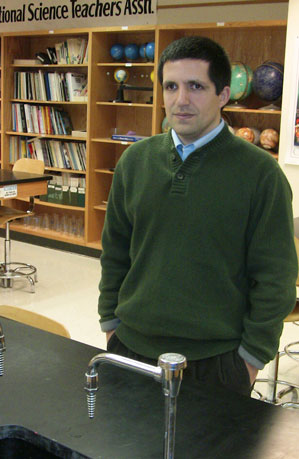Study from IU researchers indicates multiple pathways to STEM fields
National survey of nearly 8,000 gauges sources of interest and reasons for choosing STEM fields
A new study by Indiana University School of Education researchers sheds new light on the pathways students take to STEM careers, finding that the route is rarely direct.
The study “The Nature of Experiences Responsible for the Generation and Maintenance of Interest in STEM,” published in the journal Science Education, is authored by Adam Maltese, associate professor of science education, along with Christina Melki and Heidi Wiebke, both doctoral students in science education.
Policymakers at all levels are emphasizing the need for more students in STEM fields: science, technology, engineering and mathematics. Given that emphasis, many are focused on what might best influence students to pursue academic degrees and careers in these areas.
Data for the study comes from nearly 8,000 participants from both STEM and non-STEM disciplines. The bulk of participants are from two- and four-year colleges and universities around the United States, with other participants answering a survey posted on the Scientific American website. While the researchers say it is not necessarily a strictly representative sample of the U.S. population, it is large and diverse enough to give a good indication of factors influencing student choice.
The researchers found respondents cited different influences at different ages as key factors upon their academic and career choices.
“We see a few trends in the data showing more preferential pathways to STEM,” Maltese said. “But generally the results indicate that there are many combinations of the events and timing that spark and maintain interest. This precludes finding a 'silver bullet' intervention, but it is really important as it indicates there are multiple ways to enter these paths.”
Among the findings in the study:
- The majority of respondents (both those who persisted in STEM and those who did not) indicated a first interest in STEM came before sixth grade. However, a further analysis of responses indicated that individuals who reported a first interest in middle school, high school or early college showed an increasingly greater likelihood of completing a STEM degree than those with very early interest triggers. “While these results support prior research indicating the importance of early experiences, we also see that experiences more proximal to college are associated with higher odds of pursuing STEM,” Maltese said.
- Most respondents (34 percent) reported developing interest in STEM on their own or independently, with influence of parents (29 percent) and teachers (26 percent) just behind. However, further statistical modeling revealed no single group of influencers had a significant relationship with completion of a STEM major. Teachers become a primary source of influence for STEM interest as students get older. “Individuals who become interested in STEM prior to elementary school tend to develop this interest innately or through their interactions with parents,” Wiebke said. “However, individuals who become interested in STEM later in life often report influence by their teachers. These findings seems realistic in relation to who individuals spend the most time with prior to and after beginning school.”
- Most students who persisted in STEM through middle school, high school and college referred to their own interest or passion for the field as being the most critical factor. “Our findings corroborate previous research, indicating that an interest or passion for science can be developed at many age levels and, furthermore, that it’s critical to individuals’ tenacity in obtaining a degree in the field,” Melki said. “In addition, elements indicating internal or intrinsic interest lead to higher odds of completing a STEM degree than other external source of interest in STEM. The critical role of intrinsic interest shouldn’t discourage our efforts to encourage students to enter STEM fields; however, as the literature also suggests, this personally driven interest can develop over time. Instead, as educators, our purpose becomes not just to teach content for understanding but also to teach to stimulate passion.”
- Regardless of pursuing STEM or non-STEM paths in college, most individuals reported that interest and enjoyment in their field of choice was the main research they selected their major. However, individuals who said they entered college intending to major in a STEM field and said they pursued STEM primarily because of their own interest in the field were significantly less likely to have changed majors at a later point than non-STEM majors.
While the findings indicate a range of factors influencing STEM career pathways, the researchers say the results give some important insight for future policy on encouraging STEM students.
“This is one of the first times research has focused on both the generation and maintenance of interest,” Maltese said. “While many individuals report getting interested in STEM early, for one reason or another they lose interest in STEM or gain stronger interest in other areas, and these experiences play a key role in their decisions when selecting an academic or career field.
"It’s important to think about ways to improve student STEM experiences across the span of youth, as for some an experience might initiate their interest while for others the same experience may deepen their interest in a topic.”
Maltese added that the team plans to continue this work and investigate differences in experiences across genders, racial and ethnic groups, and countries.
 Adam Maltese, associate professor of science education at the IU School of Education.
Adam Maltese, associate professor of science education at the IU School of Education.